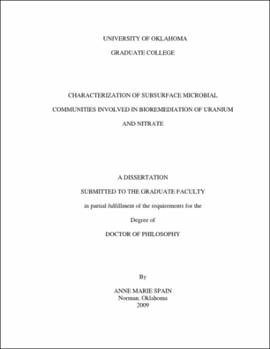| dc.description.abstract | Mining and enrichment of uranium (U) for nuclear weapons and energy has left this radionuclide an important groundwater contaminant in the United States and worldwide. Migration of U in groundwater can be prevented by U immobilization which can be achieved through microbial reduction of soluble U(VI) to insoluble U(IV) upon electron donor addition. One of the major concerns regarding U bioremediation is the presence of nitrate, which serves as a competitive electron acceptor in the subsurface, inhibiting or retarding U(VI) reduction efforts; as well, intermediates of nitrate respiration (or denitrification) can lead to U(IV) oxidation and remobilization. Experiments performed in this study aimed to characterize subsurface microbial communities involved in U and nitrate reduction. In microcosm experiments, we stimulated sulfate-reducing, Fe(III)-reducing, and methanogenic populations in landfills sediment and found that U(VI) reduction occurred under each set of conditions, and that molybdate inhibited U(VI) reduction, regardless of the occurrence of sulfate reduction, or presence of sulfate or stimulation of sulfate-reducing bacteria. From in situ field experiments designed for bioremediation of acidic high-nitrate and U-contaminated aquifers (at a site, located in Oak Ridge, TN, designated the OR-IFRC) with ethanol as an electron donor, we found through molecular and cultivation techniques that Betaproteobacteria, namely species within the genus Castellaniella, are stimulated upon ethanol addition and are likely involved in in situ nitrate removal. Lastly, through the isolation and characterization of denitrifying bacteria from OR-IFRC biostimulated sediment and groundwater, we found that different isolates are likely involved in different stages of denitrification in OR-IFRC groundwater. Specifically, we have isolates belonging to the genera Pseudomonas, Castellaniella, and Rhizobium are important in nitrate reduction, nitrite reduction, and nitrous oxide reduction, respectively. Lastly, we have shown that pH and nitrite tolerance are likely key factors contributing to the growth and survival of Castellaniella species in acidic, high nitrate aquifers at the OR-IFRC. | |
